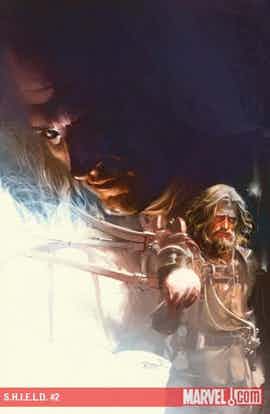
“S.H.I.E.L.D.” #1 was an impressive debut. This second issue may be even better.
It would have been so easy for Jonathan Hickman to write a generic “S.H.I.E.L.D.” comic and provide some of the backstory on the relationship between the various super-spy and super-science organizations and how they came to be. If anyone had said to me, “hey, there’s going to be this Marvel comic that explores that stuff,” I would have pictured what, I assume, most others would have pictured: some guys in fedoras, some Cold War intrigue, a slightly-younger Nick Fury, some high-tech gear inspired by the work of Kirby and Steranko.
Hickman goes in a completely different direction, and it’s better than I could have ever imagined. And artist Dustin Weaver? That guy is an immediate superstar, two issues into his first Marvel series.
“S.H.I.E.L.D.” is about the backstory of the once-and-future Nick Fury-centric organization, but Hickman takes us, in this issue, on a tour through the kind of weirdness that we don’t tend to see in a Marvel comic. This is a series about the web of intrigue that has spawned S.H.I.E.L.D., but it’s a time-traveling, nightmarish, shockingly unexpected kind of story. And Leonardo da Vinci is a main character, a brilliant one.
Hickman implies a much deeper story than he actually provides in this issue, and that kind of depth of texture helps to make Hickman’s version of Marvel history all the more exotic and substantial. The core story in this series seems to be about the awakening of a young man named Leonid, “the source of the machine,” according to da Vinci, whatever that means. And Leonid’s father is some kind of twisted villain, or maybe he’s not. Everything in this series is suspect, not because Hickman and Weaver tell the story in an unclear manner, but because there’s clearly a lot going on with these characters, and two issue in, we only have a taste of it. We’re too close to the action to have any sense of perspective on what it all means.
Luckily, we have da Vinci as a guide.
At one point in the story, Hickman stops the graphic narrative and gives us a text page of dialogue. It’s not a supplemental page in the back of the issue — it’s part of the story itself, as da Vinci and Leonid (who’s name, so close to “Leonardo,” must be something more than a coincidence), travel through the “Iter,” or a hole in spacetime. The text page signifies travel through a different kind of landscape and it manages to pack important exposition into a single page in a way that feels innovative, even if it’s just words on a page without any corresponding pictures. Nothing fancy about that. Unless you’re telling a comic book story, when panels and artwork are the standard. That Hickman would fearlessly break free from the normal storytelling conventions, and tell an expansive story like this within the Marvel mainstream, well, it deserves all the attention it can get.
Hickman and Weaver are doing something special here. It’s the best new comic of the year, without a doubt. And Galactus is on the next issue’s cover, so it doesn’t look like it’s going to slip off the edge of greatness anytime soon.

